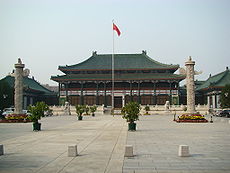- National Library of China
-
National Library of China 
The old buildings of the library, now (since 1987) the branch of the National Library of China that houses historical and ancient books, documents and manuscripts Established 1909 Location Beijing,  China
ChinaCollection Size 24,100,000 volumes[1] Access and use Circulation library does not publicly circulate Population served members of the public Other information Director Mr. Zhou Heping Website http://www.nlc.gov.cn/en/indexen.htm The National Library of China (simplified Chinese: 中国国家图书馆; traditional Chinese: 中國國家圖書館; pinyin: Zhōngguó guójiā túshūguǎn) or NLC in Beijing is the largest library in Asia,[2][3][4] and one of the largest in the world with a collection of over 23 million volumes.[5][6][7] It holds the largest and among the richest worldwide collections of Chinese literature and historical documents.[3]
The forerunner of the National Library of China, the Capital Library, was founded on 24 April 1909 by the Qing government.[8] The name of the library was at that time 'The Metropolitan Library' (Jīngshī túshūguǎn, 京师图书馆). It was first formally opened after the Xinhai Revolution, in 1912. In 1916, the library received depository library status.[3] In July 1928, its name was changed to National Beijing Library and was later changed to the National Library.
The National Library of China's collection inherited books and archives from the "Imperial Wenyuange Library" collection of the Qing Dynasty and that, in turn, included books and manuscripts from the library of the Southern Song Dynasty.[9] The library also contains inscribed tortoise shells and bones, ancient manuscripts, and block-printed volumes.[10] Among the most prized collections of the NLC are rare and precious documents and records from past dynasties in Chinese history, and it also houses official publications of the United Nations and foreign governments and a collection of literature and materials in over 115 languages.[3]
Notable collections and items in the library are:
- a collection of over 270,000 ancient and rare Chinese books and historical documents, and over 1,640,000 traditional thread-bound Chinese books[3]
- over 35,000 inscriptions on oracle bones and tortoise shells from the Shang Dynasty (c. 16th–11th century BC)[3][10]
- more than 16,000 volumes of precious historical Chinese documents and manuscripts from the Mogao Caves in Dunhuang[3]
- copies of Buddhist sutras dating to the 6th century[9]
- old maps, diagrams, and rubbings from ancient inscriptions on metal and stone[9]
- rare copies of ancient manuscripts and books of Five Dynasties periods, including a large number of ancient manuscript volumes on different subjects[9]
- books and archives from imperial libraries dating to the Southern Song Dynasty (c. 1127)[10]
- the most complete surviving Ming Dynasty copies of the Yongle Encyclopedia ("Great Canon of the Yongle Era")[9][11]
- a copy of the Siku Quanshu ("Complete Library of the Four Branches of Literature") of the Qing Dynasty[9]
- essential literary and books collection from Qing Dynasty's imperial colleges and renowned private collectors[10]
See also
- Libraries in the People's Republic of China
- List of libraries
- List of national libraries
- Chinese Library Classification (CLC)
- Archives in the People's Republic of China
References
- ^ The National Library of China in Brief. National Library of China.
- ^ "National Library of China to Add Its Records to OCLC WorldCat". Information Today. 2008-03-06. http://newsbreaks.infotoday.com/wndReader.asp?ArticleId=41153.
- ^ a b c d e f g "The National Library of China (NLC) Advancing Towards the Twenty-first Century". National Library of Australia. http://www.nla.gov.au/lap/98china.html.
- ^ "National Library of China to add its records to OCLC WorldCat". Library Technology Guides. 2008-02-28. http://www.librarytechnology.org/ltg-displayarticle.pl?RC=13100.
- ^ "From Tortoise Shells to Terabytes: The National Library of China's Digital Library Project". Library Connect. http://libraryconnect.elsevier.com/lcn/0403/lcn040302.html.
- ^ "The Development of Authority Database in National Library of China". Science Links Japan. http://sciencelinks.jp/j-east/article/200401/000020040103A0846110.php.
- ^ "Columbia University Libraries and the National Library of China Sign Cooperative Agreement". Columbia University Libraries. 2008-11-25. http://www.columbia.edu/cu/lweb/news/libraries/2008/2008-11-25.nlc.html.
- ^ Hwa-Wei Lee
- ^ a b c d e f National Library of China. Encyclopædia Britannica Online
- ^ a b c d National Libraries. Encyclopædia Britannica Online
- ^ "China mega-book gets new life". CNN. 2002-04-18. http://edition.cnn.com/2002/WORLD/asiapcf/east/04/18/china.book/.
External links
- National Library of China (official website)
- National Digital Library of China - Electronic Resources
Notable buildings and structures in Beijing from the modern era Beijing National Stadium · Beijing National Aquatics Centre · Beijing National Indoor Stadium · Beijing Railway Station · CCTV Headquarters · CCTV Tower · The China World Trade Center · Diaoyutai State Guesthouse · Great Hall of the People · Mausoleum of Mao Zedong · Military Museum of the Chinese People's Revolution · Monument to the People's Heroes · National Centre for the Performing Arts · National Library of China · National Museum of China · National Art Museum of China · Workers Stadium · Workers Indoor ArenaCoordinates: 39°56′45″N 116°19′21″E / 39.9458711944°N 116.322362417°E
Categories:- Education in the People's Republic of China
- Libraries in China
- Buildings and structures in Beijing
- National libraries
- World Digital Library
Wikimedia Foundation. 2010.
